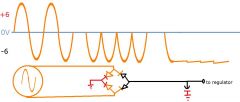
mike00
Members-
Posts
25 -
Joined
-
Last visited
Reputation
0 NeutralProfile Information
-
Gender
Male
-
Location
southern illinois
-
Interests
cars, audio, electronics
Contact Methods
-
Occupation
industrial maintenance
-
it may be a setup with 6V points, are they the original style points?
-
in order to use a six volt alternator to charge a 12 volt system, while still charging the six volt system, you could add something like this, to double the voltage, note the ripple frequency is half what it was before, making the ripple voltage (little sawtooth looking bit on the waveform towards the output) double what it is using it for 6v also this system could be used with a large capacitor and no second battery if not too much current is required at 12V, but without a battery, all 12V power would be dead when the motor isnt running.
-
what i meant when i said "If you wanted to use a 12V battery, you could actually charge it off of a 6V alternator" was that you can, an alternator typically works as such, frequency being a multiple of engine speed the alternators probally a three phase design, but the ideas the same (just uses more diodes)
-
No, Two six volts batteries, The main battery is always hooked up as normal. The Auxiliry battery can either be charged in parallel with the main system, or can add the 6 volts above ground to make 12 for the accessories. but not both at the same time.
-
unlike a generator, an alternator alternates current, and voltage.... AC. its rectified making pics now
-
http://p15-d24.com/gallery/image/1890-aux-battery-6-12v/
-
-
Thats a good way to do it. If you wanted to use a 12V battery, you could actually charge it off of a 6V alternator (but not a 6v generator) at the same time as the 6v (original voltage plus 6v+). I like your way too. if you wanted you could add a switch something like this... (see pic) of course you wouldn't be able to use your 12V stuff while charging, but you could charge it without hooking it up to a charger. resistor value depends on charge limit, which depends on charge rate - - depends on how sturdy of a switch, alternator capacity, battery condition, etc. - - - the switch is a "double pole double throw" (dpdt) switch NON-SHORTING (or "break before make") type contacts - - using shorting or "make before break" types will burn something also its never a bad idea to throw fuses in there wherever they seem to fit
-
I'm still looking for a nice '50 Meadowbrook or Coronet. I could do without it, but after I find one and check it over and everything, I'll probally add a 12V conveinence outlet just for random accessories.
-
found a nice solid '50 meadowbrook, things to look for?
mike00 replied to mike00's topic in P15-D24 Forum
thanks for the pics meadowbrook. did everything you needed come in that kit? also how reliable/troublesome are the gyromatics? -
found a nice solid '50 meadowbrook, things to look for?
mike00 replied to mike00's topic in P15-D24 Forum
....." it was my understanding that while they both had the same fluid coupler " ....." marketed as "fluid drive" " ....." ones called "gyro-matic" " @ Dan - I know -
found a nice solid '50 meadowbrook, things to look for?
mike00 replied to mike00's topic in P15-D24 Forum
i found another vechicle i might be interested in instead, a 1950 coronet (a huge change in plans) i have a couple questions about this car 1 - is there any such thing as the owner describes "three on the tree and an automatic option"? it was my understanding that while they both had the same fluid coupler, the transmissions marketed as "fluid drive" were three on the tree while the ones called "gyro-matic" have two ranges, each of which automatically shift between two gears. and that the "fluid drive" was more common on the meadowbrook, while the "gyro-matic" was more common on the coronets. is this correct? was there any other options in a 1950 coronet? 2 - did any of these come from the factory with a sun visor? (outside type) -
also solid-state regulators exist. voltage can be dropped by diodes as well (zener diodes would work best) plus you dont have to worry about (probally minute anyway) changes in current, due to changes in resistance, due to things like temperature, load (how much water wipers are moving, and at what speed your traveling (wind pressure on the glass.) )



